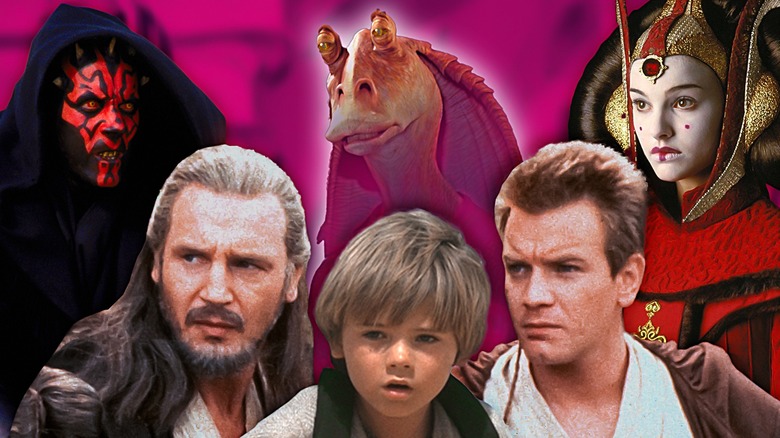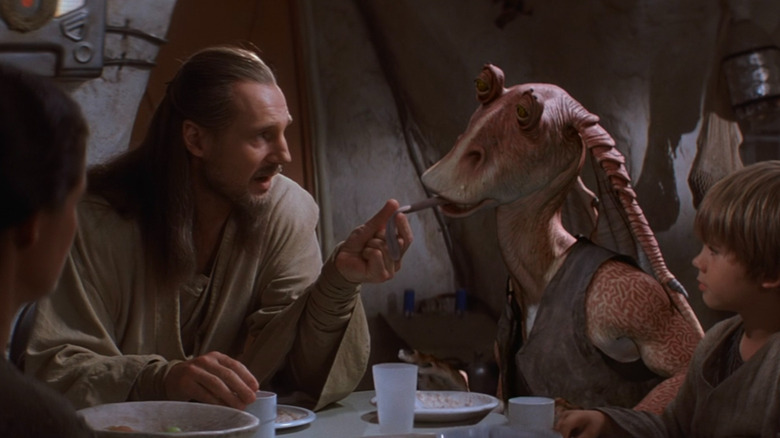Star Wars: Episode I Without Jar Jar Binks Does Exist - But You'll Likely Never See It
Even those with a soft spot for "Star Wars: Episode I — The Phantom Menace" are unlikely to find a substantial narrative reason for the film's blatant comic relief: Jar Jar Binks (Ahmed Best). One fan took matters into their own hands regarding this aspect — by cutting the Gungan out almost entirely. But those hoping to see the legendary edit are in for a letdown.
In 2000, a mysterious project dubbed "The Phantom Edit" began circulating among Star Wars diehards. This version, pieced together by editor Mike J. Nichols using a VHS of the original film, cut out 20 minutes to address numerous complaints viewers had about the prequel. Along with removing mention of midi-chlorians, scrapping Anakin Skywalker's (Jake Lloyd) many cutesy lines, and trimming many of the drawn-out political speeches, Nichols also chopped down Jar Jar's role to the bare minimum.
When discussing his choice to cut out the underwater city scene featuring Jar Jar, Obi-Wan Kenobi (Ewan McGregor), and Qui-Gon Jinn (Liam Neeson) with Zap2it, Nichols expressed that most of the goofy alien's screen time sacrificed narrative importance to show off the movie's groundbreaking effects. "The mass of that scene is to establish that Jar Jar was banished and he is clumsy. Do we really need to be told that?" he stated. "The audience knows both these elements way before this scene so then the scene remains in the film as a showpiece for ILM visual effects. By [George] Lucas' own rule, showcasing effects and sets is the reason most fantasy and sci-fi films fail."
Whatever happened to The Phantom Edit?
Ironically enough, the same revolutionary computer technology that created "Star Wars: Episode I — The Phantom Menace" allowed fans to tamper with it, as was the case for Mike J. Nichols' "The Phantom Edit." But while the Jar Jar-free rendition appeased plenty of fans, the joyride didn't last long.
Initially, Nichols' version was made as little more than an exercise in editing and storytelling. But after sharing a copy with some friends, it gained traction, with Nichols receiving congratulatory emails from viewers around the world. Even filmmaker and Star Wars fan Kevin Smith, who was long rumored to be responsible for the fan edit, praised the new version, saying in an interview with the Pittsburgh Post, "Some of these edits make the movie flow a lot better. Smart editing to say the least."
At first, Lucasfilm didn't make much fuss about the re-edit, but as it gained greater attention globally, the studio grew more vocal. Lucasfilm representative Jeane Cole told Zap2it (via Salon), "When we started hearing about massive duplication and distribution, we realized then that we had to be very clear that duplication and distribution of our materials is an infringement. And so we just kind of want to put everybody on notice that that is indeed the case." Not long after, Nichols, who never made any money from the project, released a statement apologizing to Lucasfilm and discouraging fans from sharing it.
Nowadays, finding a copy of "The Phantom Edit" is near impossible; it may be considered lost media. Nevertheless, it remains a unique piece of Star Wars history that shows how far fans are willing to go to preserve their favorite franchise.

